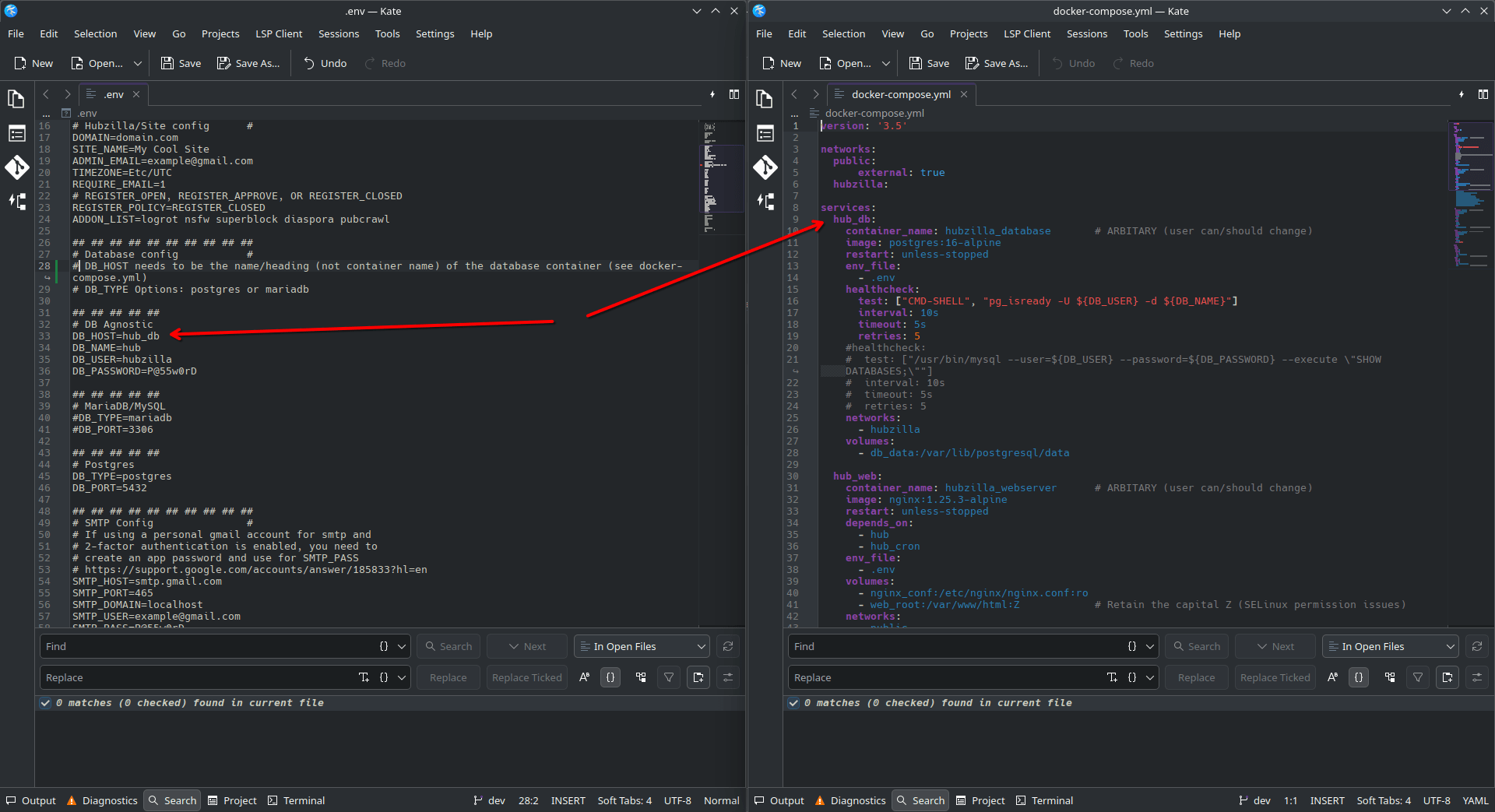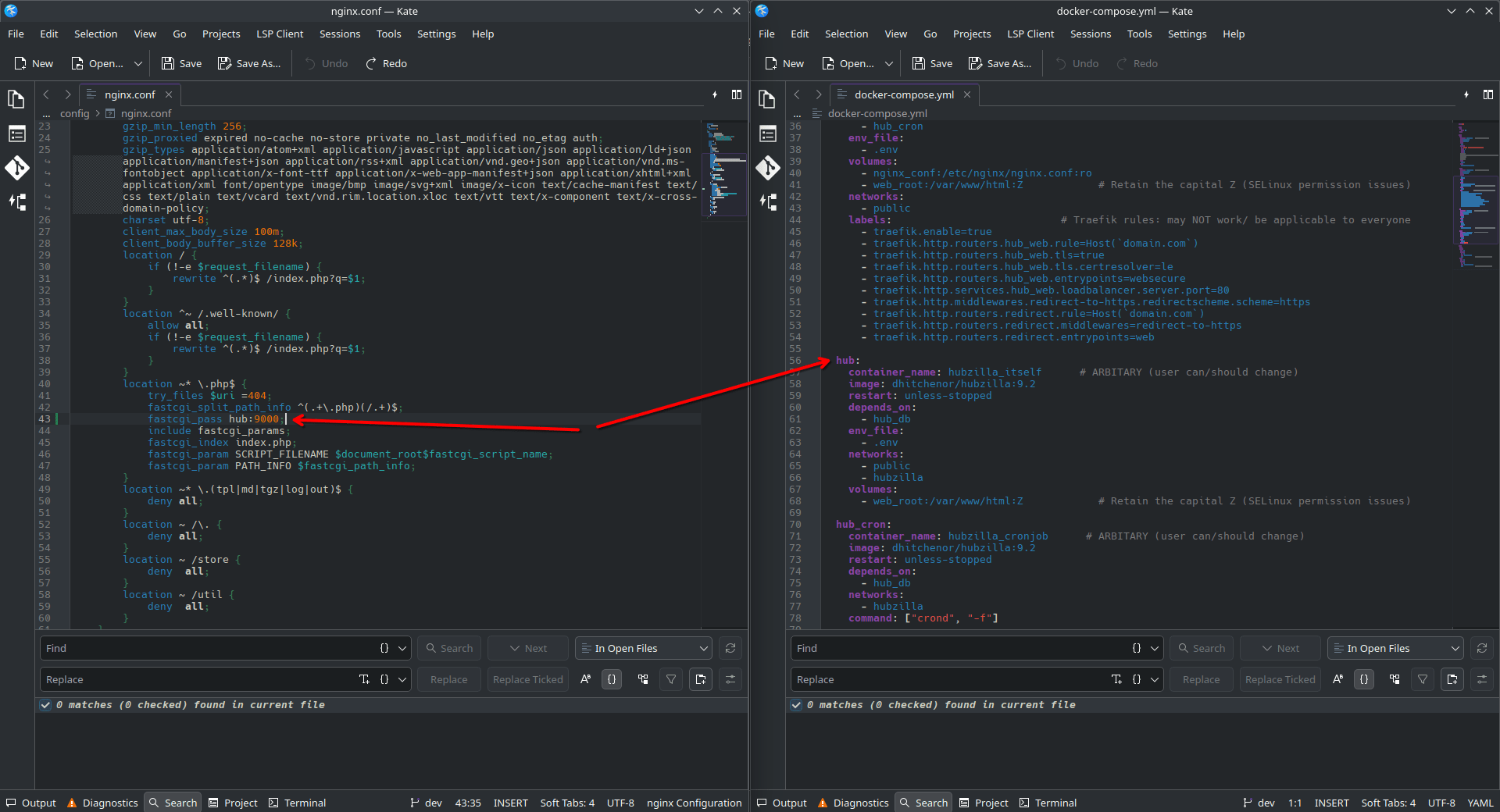Hubzilla as a docker image (based on php:8.2-fpm-alpine) in a multi-arch (amd64, armv6/7, arm64) format.
- Automatic setup
- Integral addons, preinstalled
- env file for easy configuration/toggling of features
| Variable | Description |
|---|---|
| DB_TYPE | Database type: postgres or mysql |
| DB_HOST | Host name of the database |
| DB_PORT | Database port number, set to empty to use the default of your DB_TYPE (aka 3306 for mysql) |
| DB_NAME | Database name |
| DB_USER | Database user |
| DB_PASSWORD | Database user password |
| REQUIRE_EMAIL | Require email address to register |
| REGISTER_POLICY | Allow (or disallow) new user registrations |
| SMTP_HOST | Mail server hostname |
| SMTP_PORT | Mail server port number |
| SMTP_USER | User name for the mail server |
| SMTP_DOMAIN | Mail domain |
| SMTP_PASS | Password for the user on the mail server, if set empty, then no authentication on the smtp server will be used |
| DOMAIN | Web domain name for hubzilla |
| ADMIN_EMAIL | Administrators email of the deployed hub |
| REDIS_PATH | If set (to something like " tcp://redis") then php sessions will be stored in this redis server (useful for horizontal scalability) |
| LDAP_SERVER | LDAP server name (dont forget to add "ldapauth" to the ADDON_LIST) |
| LDAP_ROOT_DN | LDAP username to connect to (ex: cn=admin,dc=domain,dc=com) |
| LDAP_ADMIN_PASSWORD | Password for that LDAP user |
| LDAP_BASE | Path to look for users in the directory (ex: ou=people,,dc=domain,dc=com) |
| ADDON_LIST | Addons to install/activate during initial configuration |
- eg:
git clone https://github.com/dhitchenor/hubzilla- NOTE: you will need to install git for this to work, otherwise you can download the repository in a zip file from GitHub
- on line 19, change
domain.comto your desired server name (eg. funnylookingfaces.com, or www.potatogram.net) - on line 43, change
hub:9000to match the name (not, container name) of your hubzilla container in your docker-compose.yml file
- depending on how your infrastructure is structured, change the following items appropriately
- LOC_NGINXCONF: the location where the nginx.conf FILE is located (by default, it is in the config folder, which is in the same directory as the docker-compose file)
- LOC_DB: the folder location (directory), where the database should be stored (is your Database stored locally, or on another server?)
- change the
DOMAINvalue to reflect the domain name that you changed earlier, in thenginx.conffile
- depending on the database that you are using, uncomment/comment the appropriate lines, ENSURE the code for the unused database is commented out
- HINT: don't change any port numbers, unless you have to; including database ports, nginx ports, hubzilla ports
- change the
DB agnosticoptions to reflect your desired database credentials- HINT: if you already have a database, you will need to change the values of
DB_NAME,DB_USER, andDB_PASSWORDto reflect that database; if no database is present, a database is created for you using these details - HINT:
DB_HOSTshould match the name (not, container name) of the database container used for hubzilla or within the docker-compose.yml file (see screenshot)
- HINT: if you already have a database, you will need to change the values of
- depending on the database that you are using, uncomment/comment the appropriate healthcheck lines, ENSURE the code for the unused database is commented out
- HINT: default database is postgres; unless you want to use MySQL, you won't need to touch this
- if you have changed the location of any files that you gained when cloning this git repository, ensure the changes are reflected within the docker-compose.yml file
- HINT: by default, the '.env' file should be in the same directory as the docker-compose file
- HINT: by default, the nginx.conf file is in the config folder, which is in the same directory as the docker-compose file
- eg,
docker-compose up -d(ordocker-compose upif you want to see the output of the deployment), and navigate to your domain (in a web browser), after deployment has finished.- NOTE: the new version of docker compose is out (usage:
docker compose up -dordocker compose upif you want to see the output, as before) - the
versionlevel in the docker-compose.yml file is not necessary in the new version of docker compose; for backwards compatibility, it has been retained
- NOTE: the new version of docker compose is out (usage:
